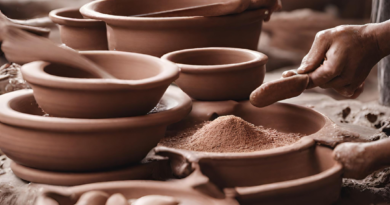Can clay pots be used for slow cooking? (Quick Answer)
Yes, clay pots are exceptionally well-suited for slow cooking, and they have been used for this purpose in various culinary traditions for centuries. Slow cooking in clay pots allows for the gentle and even distribution of heat, moisture retention, and flavor concentration, resulting in tender and flavorful dishes. Here’s why clay pots are perfect for slow cooking:
1. Even Heat Distribution: Clay pots have a unique ability to distribute heat evenly throughout the cooking vessel. This ensures that food cooks uniformly, preventing hot spots and overcooking in some areas while undercooking in others. The even heat is particularly valuable for slow-cooked dishes that require consistent cooking temperatures.
2. Moisture Retention: Clay pots are porous, and this porosity allows them to absorb and slowly release moisture during cooking. As a result, the cooking environment within the pot remains moist and humid. This moisture retention prevents dishes from drying out, keeping them succulent and tender throughout the slow cooking process.
3. Flavor Enhancement: The slow cooking process in clay pots allows flavors to meld and develop over time. As moisture is released from the pot’s pores, it continuously bathes the ingredients in their own juices, creating a self-basting effect. This contributes to the depth and complexity of flavors in slow-cooked dishes.
4. Tenderizing Tough Cuts: Clay pots are particularly effective at tenderizing tough cuts of meat. The low, steady heat and moisture retention break down collagen and connective tissues in meat, transforming it into tender, melt-in-your-mouth goodness.
5. Aromatics and Spices: The porous surface of clay pots helps absorb and intensify the aromas and flavors of herbs, spices, and other seasonings, infusing dishes with rich and well-developed tastes.
6. Versatility: Clay pots can be used to slow cook a wide range of dishes, including stews, braises, soups, roasts, and even desserts. The versatility of clay pots makes them an essential tool for anyone who appreciates slow-cooked meals.
When slow cooking in clay pots, it’s essential to follow some guidelines:
– Pre-Soak: Before using your clay pot for slow cooking, soak it in water for 15-30 minutes. This prevents the pot from absorbing too much moisture from your dish during cooking.
– Cold Start: Begin cooking in a cold clay pot and gradually increase the heat to prevent thermal shock and potential cracking.
– Monitor Liquid Levels: Be mindful of the amount of liquid you add to your dish. Clay pots retain moisture well, so you may need less liquid compared to other cooking vessels. Monitor the liquid level during cooking to ensure your dish doesn’t dry out.
– Avoid Rapid Temperature Changes: When removing a hot clay pot from the oven or stovetop, avoid placing it on a cold surface, as this can lead to thermal shock.
By following these guidelines, you can harness the slow cooking potential of clay pots to create tender, succulent, and flavorful dishes that are sure to impress.



